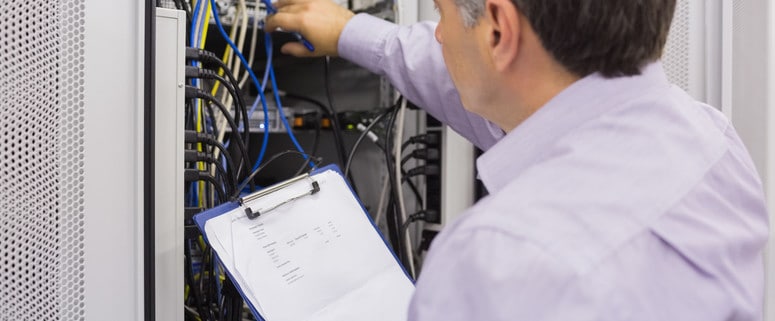How to Create a Small Business Server Room in 2023
Last Updated on March 24, 2023
The importance of data security and privacy has never been greater. With the growing number of cyber threats and increasing awareness of data vulnerabilities, many small businesses are considering establishing their server rooms. In this updated guide, we will walk you through six essential steps for setting up a secure, efficient, cost-effective server room for your small business.
Table of Contents
Invest in Rack-Mountable IT Equipment
This will allow you to organize and protect your hardware better, reducing the risk of physical damage, environmental hazards, and tampering. Although rack-mountable equipment may be more expensive than non-rack alternatives, the benefits of organization and security far outweigh the costs.
Choose the Right Server Rack for Your Needs
Server racks come in various sizes, so selecting the appropriate size for your equipment is essential. Racks are measured in “U” or “RU” (rack units), with 1U equal to 1.75 inches (44.5mm) in height. Consider the width and depth of your server racks, as well as any additional features like adjustable rear brackets or caster wheels for easy movement. For small spaces, consider open-frame racks or wall-mounted cabinets.
Reduce Noise with Server Separation and Soundproofing
To minimize noise and prevent unauthorized access, create a separate space for your server room. If a dedicated room is unavailable, invest in soundproof racks that reduce noise levels. This will help maintain a quiet and productive working environment for your staff.
Install an Appropriate Air-Conditioning Unit
Proper cooling is crucial for maintaining the longevity and performance of your IT equipment. Install an air-conditioning unit in your server room to prevent overheating, outages, and crashes. For the best results, use separate stand-alone units with different circuit breakers, allowing regular maintenance without interrupting server operation.
Manage Cables for Proper Ventilation
Good cable management is critical to ensuring adequate airflow and preventing cable-related accidents. Use RJ45 patch panels to terminate Ethernet cable runs, and invest in cable ties to secure stray cables. Proper cable management will improve server performance and make it easier to troubleshoot and maintain your server room.
Label and Document Your Infrastructure
Finally, label and document your entire server room infrastructure. This will make it easier for new staff or vendors to understand your system and quickly address any issues. Use a label printer to create clear, descriptive labels for all equipment and keep detailed notes on operating procedures, data backups, and other essential tasks.
Setting up a small business server room is manageable when you follow these simple steps. Investing in the right equipment and organizing your server room ensures your IT infrastructure's security, efficiency, and longevity. If you need further assistance or advice, contact iFeeltech for a free consultation or explore our range of IT services.
Server Rack Equipment to Consider
To ensure a secure and efficient environment, consider investing in the following top server rack equipment:
- Rack Enclosures: Start with a high-quality server rack enclosure, providing a secure and organized space for your servers and network equipment. Consider the size, weight capacity, and ventilation when choosing the proper enclosure. The four-post rack is a popular choice, designed to hold appliances and servers up to 19 inches wide.
- Power Distribution Units (PDUs): Efficient power management is essential for your server room. PDUs help distribute power to multiple devices and often include features like surge protection and remote monitoring.
- Uninterruptible Power Supply (UPS): Invest in a UPS system to protect your equipment from power outages and voltage fluctuations. This will provide backup power to keep your servers running during short outages and allow for a safe shutdown during more extended outages.
- Cable Management Accessories: Proper cable management is crucial for maintaining airflow and reducing the risk of accidents. Invest in accessories like cable ties, Velcro straps, and cable management bars to keep your server room organized and clutter-free.
- KVM Switches: A Keyboard, Video, and Mouse (KVM) switch allows you to control multiple servers from a single console, reducing the need for multiple peripherals and saving valuable space in your server room.
- Cooling Solutions: Servers and network equipment generate heat, which can shorten their lifespan and cause performance issues. To maintain optimal temperatures, invest in adequate cooling solutions like air-conditioning units, fans, or rack-mount cooling systems.
- Network Switches: Invest in high-quality network switches for your server room to ensure fast and reliable connectivity. Look for switches with features like Gigabit Ethernet, Power over Ethernet (PoE), and VLAN support.
- Patch Panels: Patch panels help organize and manage your Ethernet cables, simplifying maintenance and reducing clutter in your server room. Opt for a patch panel with enough ports to accommodate your current needs and allow for future growth.
- Security Solutions: Protect your server room from unauthorized access with security solutions like biometric access control systems, security cameras, and rack-mount door locks.
Investing in this essential server rack equipment will create a secure, efficient, and organized environment for your small business's IT infrastructure. For more advice on setting up a server room, consider contacting an IT service professional for a consultation.











I found this article to be very helpful in creating a small business server room. The author does a great job of covering all of the important aspects of server room design, from choosing the right location to setting up security measures. I would definitely recommend this article to anyone who is considering setting up a server room for their small business.
Here are some additional tips that I found helpful:
Make sure that the server room is in a secure location. This could mean a locked room in your office, or a dedicated space in a co-working space.
Invest in a good UPS system. This will protect your servers from power outages.
Make sure that the server room has adequate ventilation. This will help to keep your servers cool and running smoothly.
Regularly monitor your server room for any signs of problems. This could include things like overheating, power outages, or security breaches.
I hope this helps!